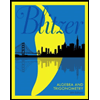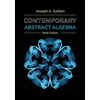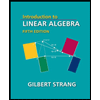
EBK GRAPHICAL APPROACH TO ALGEBRA & TRI
7th Edition
ISBN: 9780134674377
Author: Rockswold
Publisher: VST
expand_more
expand_more
format_list_bulleted
Concept explainers
Question
Chapter 4.3, Problem 69E
To determine
To find: The factor
Expert Solution & Answer
Want to see the full answer?
Check out a sample textbook solution
Students have asked these similar questions
4) A researcher gathered data on the amount of time students spent studying per week. Given the following
frequency distribution, fill in the relative and cumulative frequency.
Hours per week:
at least
Frequency
Relative Frequency
Cumulative Relative
Frequency
0 but less than 2
4
2 but less than 4
15
4 but less than 6
41
6 but less than 8
20
8 but less than 10
7
10 or more
3
a) What percentage of students study less than 6 hours per week?
options are greater than less than or about the same as
A candy machine contains over \[1{,}000\] pieces of candy, \[30\%\] of which are blue. Customers get an
SRS
of \[15\] candies in a purchase. Let \[X=\] the number of blue candies that a random customer gets in a purchase.
Find the mean and standard deviation of \[X\].You may round your answers to the nearest tenth.
Chapter 4 Solutions
EBK GRAPHICAL APPROACH TO ALGEBRA & TRI
Ch. 4.1 - CONCEPT CHECK Use the polynomial function graphs,...Ch. 4.1 - CONCEPT CHECK Use the polynomial function graphs,...Ch. 4.1 - CONCEPT CHECK Use the polynomial function graphs,...Ch. 4.1 - CONCEPT CHECK Use the polynomial function graphs,...Ch. 4.1 - CONCEPT CHECK Use the polynomial function graphs,...Ch. 4.1 - CONCEPT CHECK Use the polynomial function graphs,...Ch. 4.1 - CONCEPT CHECK Use the polynomial function graphs,...Ch. 4.1 - CONCEPT CHECK Use the polynomial function graphs,...Ch. 4.1 - Use an end behavior diagram , , , or to describe...Ch. 4.1 - Use an end behavior diagram , , , or to describe...
Ch. 4.1 - Use an end behavior diagram , , , or to describe...Ch. 4.1 - Use an end behavior diagram , , , or to describe...Ch. 4.1 - Use an end behavior diagram , , , or to describe...Ch. 4.1 - Use an end behavior diagram , , , or to describe...Ch. 4.1 - Use an end behavior diagram , , , or to describe...Ch. 4.1 - Use an end behavior diagram , , , or to describe...Ch. 4.1 - Use an end behavior diagram , , , or to describe...Ch. 4.1 - Use an end behavior diagram , , , or to describe...Ch. 4.1 - Use an end behavior diagram , , , or to describe...Ch. 4.1 - Prob. 20ECh. 4.1 - Prob. 21ECh. 4.1 - Prob. 22ECh. 4.1 - Prob. 23ECh. 4.1 - Prob. 24ECh. 4.1 - Prob. 25ECh. 4.1 - Prob. 26ECh. 4.1 - Prob. 27ECh. 4.1 - Prob. 28ECh. 4.1 - Prob. 29ECh. 4.1 - Prob. 30ECh. 4.1 - Prob. 31ECh. 4.1 - Prob. 32ECh. 4.1 - Without using a calculator, match each function in...Ch. 4.1 - Prob. 34ECh. 4.1 - Without using a calculator, match each function in...Ch. 4.1 - Prob. 36ECh. 4.1 - Prob. 37ECh. 4.1 - Prob. 38ECh. 4.1 - Prob. 39ECh. 4.1 - Prob. 40ECh. 4.1 - Prob. 41ECh. 4.1 - Prob. 42ECh. 4.1 - Prob. 43ECh. 4.1 - Prob. 44ECh. 4.1 - CONCEPT CHECK The graphs below show
but not...Ch. 4.1 - Prob. 46ECh. 4.1 - CONCEPT CHECK The graphs below show
y = x3 − 3x2 −...Ch. 4.1 - Prob. 48ECh. 4.1 - CONCEPT CHECK The graphs below show
but not...Ch. 4.1 - Prob. 50ECh. 4.1 - CONCEPT CHECK The graphs below show
y = x3 − 3x2 −...Ch. 4.1 - Prob. 52ECh. 4.1 - CONCEPT CHECK The graphs below show
y = x3 − 3x2 −...Ch. 4.1 - Prob. 54ECh. 4.1 - Prob. 55ECh. 4.1 - Prob. 56ECh. 4.1 - Prob. 57ECh. 4.1 - Prob. 58ECh. 4.1 - Prob. 59ECh. 4.1 - Prob. 60ECh. 4.1 - Prob. 61ECh. 4.1 - Prob. 62ECh. 4.1 - Prob. 63ECh. 4.1 - Prob. 64ECh. 4.1 - Prob. 65ECh. 4.1 - Prob. 66ECh. 4.1 - Prob. 67ECh. 4.1 - Prob. 68ECh. 4.1 - Prob. 69ECh. 4.1 - Prob. 70ECh. 4.1 - Prob. 71ECh. 4.1 - Prob. 72ECh. 4.1 - Prob. 73ECh. 4.1 - Prob. 74ECh. 4.2 - CHECKING ANALYTIC SKILLS Simplify each rational...Ch. 4.2 - CHECKING ANALYTIC SKILLS Simplify each rational...Ch. 4.2 - Prob. 3ECh. 4.2 - Prob. 4ECh. 4.2 - CHECKING ANALYTIC SKILLS Simplify each rational...Ch. 4.2 - Prob. 6ECh. 4.2 - Prob. 7ECh. 4.2 - Prob. 8ECh. 4.2 - Use the intermediate value theorem to show that...Ch. 4.2 - Prob. 10ECh. 4.2 - Prob. 11ECh. 4.2 - Prob. 12ECh. 4.2 - Use the intermediate value theorem to show that...Ch. 4.2 - Prob. 14ECh. 4.2 - Prob. 15ECh. 4.2 - Prob. 16ECh. 4.2 - Use the intermediate value theorem to show that...Ch. 4.2 - Prob. 18ECh. 4.2 - CONCEPT CHECK Suppose that a polynomial function P...Ch. 4.2 - Prob. 20ECh. 4.2 - Find each quotient when P(x) is divided by the...Ch. 4.2 - Prob. 22ECh. 4.2 - Prob. 23ECh. 4.2 - Prob. 24ECh. 4.2 - Find each quotient when P(x) is divided by the...Ch. 4.2 - Prob. 26ECh. 4.2 - Prob. 27ECh. 4.2 - Prob. 28ECh. 4.2 - Find each quotient when P(x) is divided by the...Ch. 4.2 - Prob. 30ECh. 4.2 - Prob. 31ECh. 4.2 - Prob. 32ECh. 4.2 - Use synthetic substitution to find P(k).
k = 3;...Ch. 4.2 - Prob. 34ECh. 4.2 - Prob. 35ECh. 4.2 - Prob. 36ECh. 4.2 - Use synthetic substitution to find P(k).
k = 2;...Ch. 4.2 - Prob. 38ECh. 4.2 - Prob. 39ECh. 4.2 - Prob. 40ECh. 4.2 - Use synthetic substitution to find P(k).
; P(x) =...Ch. 4.2 - Prob. 42ECh. 4.2 - Prob. 43ECh. 4.2 - Prob. 44ECh. 4.2 - Use synthetic substitution to determine whether...Ch. 4.2 - Prob. 46ECh. 4.2 - Prob. 47ECh. 4.2 - Prob. 48ECh. 4.2 - Use synthetic substitution to determine whether...Ch. 4.2 - Prob. 50ECh. 4.2 - Prob. 51ECh. 4.2 - Prob. 52ECh. 4.2 - Use synthetic substitution to determine whether...Ch. 4.2 - Prob. 54ECh. 4.2 - Prob. 55ECh. 4.2 - Prob. 56ECh. 4.2 - Prob. 57ECh. 4.2 - Prob. 58ECh. 4.2 - Prob. 59ECh. 4.2 - Prob. 60ECh. 4.2 - For each polynomial at least one zero is given....Ch. 4.2 - Prob. 62ECh. 4.2 - For each polynomial at least one zero is given....Ch. 4.2 - Prob. 64ECh. 4.2 - For each polynomial at least one zero is given....Ch. 4.2 - For each polynomial at least one zero is given....Ch. 4.2 - Prob. 67ECh. 4.2 - Prob. 68ECh. 4.2 - For each polynomial at least one zero is given....Ch. 4.2 - Prob. 70ECh. 4.2 - Prob. 71ECh. 4.2 - Prob. 72ECh. 4.2 - Factor P(x) into linear factors given that k is a...Ch. 4.2 - Prob. 74ECh. 4.2 - Prob. 75ECh. 4.2 - Prob. 76ECh. 4.2 - Factor P(x) into linear factors given that k is a...Ch. 4.2 - Prob. 78ECh. 4.2 - Prob. 79ECh. 4.2 - Prob. 80ECh. 4.2 - Divide.
Ch. 4.2 - Prob. 82ECh. 4.2 - Divide.
Ch. 4.2 - Prob. 84ECh. 4.2 - Divide.
Ch. 4.2 - Prob. 86ECh. 4.2 - Prob. 87ECh. 4.2 - Prob. 88ECh. 4.2 - Prob. 89ECh. 4.2 - Prob. 90ECh. 4.2 - Prob. 91ECh. 4.2 - Prob. 92ECh. 4.2 - Prob. 1RBCCh. 4.2 - Prob. 2RBCCh. 4.2 - Prob. 3RBCCh. 4.2 - Prob. 4RBCCh. 4.2 - Prob. 5RBCCh. 4.2 - Prob. 6RBCCh. 4.2 - Prob. 7RBCCh. 4.2 - Prob. 8RBCCh. 4.2 - Prob. 9RBCCh. 4.2 - Prob. 10RBCCh. 4.3 - CHECKING ANALYTIC SKILLS Find a cubic polynomial...Ch. 4.3 - Prob. 2ECh. 4.3 - CHECKING ANALYTIC SKILLS Find a cubic polynomial...Ch. 4.3 - Prob. 4ECh. 4.3 - CHECKING ANALYTIC SKILLS Find a cubic polynomial...Ch. 4.3 - CHECKING ANALYTIC SKILLS Find a cubic polynomial...Ch. 4.3 - CHECKING ANALYTIC SKILLS Find a polynomial...Ch. 4.3 - Prob. 8ECh. 4.3 - CHECKING ANALYTIC SKILLS Find a polynomial...Ch. 4.3 - Prob. 10ECh. 4.3 - CHECKING ANALYTIC SKILLS Find a polynomial...Ch. 4.3 - Prob. 12ECh. 4.3 - One or more zeros are given for each polynomial....Ch. 4.3 - Prob. 14ECh. 4.3 - One or more zeros are given for each polynomial....Ch. 4.3 - Prob. 16ECh. 4.3 - One or more zeros are given for each polynomial....Ch. 4.3 - Prob. 18ECh. 4.3 - Find a polynomial function P(x) having leading...Ch. 4.3 - Prob. 20ECh. 4.3 - Find a polynomial function P(x) having leading...Ch. 4.3 - Prob. 22ECh. 4.3 - Find a polynomial function P(x) having leading...Ch. 4.3 - Prob. 24ECh. 4.3 - Prob. 25ECh. 4.3 - Prob. 26ECh. 4.3 - Find a polynomial function P(x) having leading...Ch. 4.3 - Prob. 28ECh. 4.3 - Prob. 29ECh. 4.3 - Prob. 30ECh. 4.3 - Sketch by hand the graph of each function. (You...Ch. 4.3 - Prob. 32ECh. 4.3 - Sketch by hand the graph of each function. (You...Ch. 4.3 - Prob. 34ECh. 4.3 - Sketch by hand the graph of each function. (You...Ch. 4.3 - Prob. 36ECh. 4.3 - Sketch by hand the graph of each function. (You...Ch. 4.3 - Prob. 38ECh. 4.3 - Prob. 39ECh. 4.3 - Prob. 40ECh. 4.3 - CONCEPT CHECK Use the graphs in Exercises 41–46 to...Ch. 4.3 - CONCEPT CHECK Use the graphs in Exercises 41–46 to...Ch. 4.3 - CONCEPT CHECK Use the graphs in Exercises 41–46 to...Ch. 4.3 - Prob. 44ECh. 4.3 - CONCEPT CHECK Use the graphs in Exercises 41–46 to...Ch. 4.3 - Prob. 46ECh. 4.3 - Prob. 47ECh. 4.3 - Prob. 48ECh. 4.3 - Prob. 49ECh. 4.3 - Prob. 50ECh. 4.3 - Prob. 51ECh. 4.3 - Prob. 52ECh. 4.3 - For each polynomial function, (a) list all...Ch. 4.3 - Prob. 54ECh. 4.3 - For each polynomial function, (a) list all...Ch. 4.3 - Prob. 56ECh. 4.3 - For each polynomial function, (a) list all...Ch. 4.3 - Prob. 58ECh. 4.3 - Prob. 59ECh. 4.3 - Prob. 60ECh. 4.3 - Prob. 61ECh. 4.3 - Prob. 62ECh. 4.3 - Prob. 63ECh. 4.3 - Prob. 64ECh. 4.3 - Prob. 65ECh. 4.3 - Prob. 66ECh. 4.3 - Prob. 67ECh. 4.3 - Prob. 68ECh. 4.3 - Prob. 69ECh. 4.3 - Prob. 70ECh. 4.3 - Prob. 71ECh. 4.3 - Prob. 72ECh. 4.3 - Prob. 73ECh. 4.3 - Prob. 74ECh. 4.3 - Prob. 75ECh. 4.3 - Prob. 76ECh. 4.3 - Prob. 77ECh. 4.3 - Prob. 78ECh. 4.3 - Prob. 79ECh. 4.3 - Prob. 80ECh. 4.3 - Prob. 81ECh. 4.3 - Prob. 82ECh. 4.3 - Prob. 83ECh. 4.3 - Prob. 84ECh. 4.3 - Prob. 85ECh. 4.3 - Prob. 86ECh. 4.3 - Prob. 87ECh. 4.3 - Prob. 88ECh. 4.3 - Prob. 89ECh. 4.3 - Prob. 90ECh. 4.3 - Prob. 91ECh. 4.3 - Prob. 92ECh. 4.3 - RELATING CONCEPTS For individual or group...Ch. 4.3 - Prob. 94ECh. 4.3 - Prob. 95ECh. 4.3 - do the following in order.
Use Descartes’ rule of...Ch. 4.3 - Prob. 97ECh. 4.3 - Prob. 98ECh. 4.4 - Prob. 1ECh. 4.4 - Prob. 2ECh. 4.4 - Prob. 3ECh. 4.4 - Prob. 4ECh. 4.4 - Prob. 5ECh. 4.4 - Prob. 6ECh. 4.4 - Prob. 7ECh. 4.4 - Prob. 8ECh. 4.4 - CHECKING ANALYTIC SKILLS Find all real solutions....Ch. 4.4 - Prob. 10ECh. 4.4 - Prob. 11ECh. 4.4 - Prob. 12ECh. 4.4 - CHECKING ANALYTIC SKILLS Find all complex...Ch. 4.4 - Prob. 14ECh. 4.4 - Prob. 15ECh. 4.4 - Prob. 16ECh. 4.4 - CHECKING ANALYTIC SKILLS Find all complex...Ch. 4.4 - Prob. 18ECh. 4.4 - Prob. 19ECh. 4.4 - Solve each equation analytically for all complex...Ch. 4.4 - Solve each equation analytically for all complex...Ch. 4.4 - Prob. 22ECh. 4.4 - Prob. 23ECh. 4.4 - Prob. 24ECh. 4.4 - Prob. 25ECh. 4.4 - Prob. 26ECh. 4.4 - Prob. 27ECh. 4.4 - Prob. 28ECh. 4.4 - Prob. 29ECh. 4.4 - Prob. 30ECh. 4.4 - Prob. 31ECh. 4.4 - Prob. 32ECh. 4.4 - Prob. 33ECh. 4.4 - Prob. 34ECh. 4.4 - Prob. 35ECh. 4.4 - Prob. 36ECh. 4.4 - Graph each polynomial function by hand, as shown...Ch. 4.4 - Prob. 38ECh. 4.4 - Graph each polynomial function by hand, as shown...Ch. 4.4 - Prob. 40ECh. 4.4 - Graph each polynomial function by hand, as shown...Ch. 4.4 - Prob. 42ECh. 4.4 - Prob. 43ECh. 4.4 - Prob. 44ECh. 4.4 - Prob. 45ECh. 4.4 - Prob. 46ECh. 4.4 - Prob. 47ECh. 4.4 - Prob. 48ECh. 4.4 - Prob. 49ECh. 4.4 - Prob. 50ECh. 4.4 - Prob. 51ECh. 4.4 - Prob. 52ECh. 4.4 - Prob. 53ECh. 4.4 - Prob. 54ECh. 4.4 - Find all n complex solutions of each equation of...Ch. 4.4 - Prob. 56ECh. 4.4 - Prob. 57ECh. 4.4 - Prob. 58ECh. 4.4 - Find all n complex solutions of each equation of...Ch. 4.4 - Prob. 60ECh. 4.4 - Prob. 61ECh. 4.4 - Prob. 62ECh. 4.4 - Find all n complex solutions of each equation of...Ch. 4.4 - Prob. 64ECh. 4.4 - Prob. 65ECh. 4.4 - Prob. 66ECh. 4.4 - Prob. 67ECh. 4.4 - Prob. 68ECh. 4.4 - Prob. 69ECh. 4.4 - Prob. 70ECh. 4.4 - Prob. 71ECh. 4.4 - Prob. 72ECh. 4.4 - Prob. 73ECh. 4.4 - Prob. 74ECh. 4.4 - Prob. 75ECh. 4.4 - Prob. 76ECh. 4.4 - Prob. 77ECh. 4.4 - Prob. 78ECh. 4.4 - Prob. 1RBCCh. 4.4 - Prob. 2RBCCh. 4.4 - Prob. 3RBCCh. 4.4 - Prob. 4RBCCh. 4.4 - Prob. 5RBCCh. 4.4 - Prob. 6RBCCh. 4.4 - Prob. 7RBCCh. 4.4 - Prob. 8RBCCh. 4 - Prob. 1RECh. 4 - Prob. 2RECh. 4 - Prob. 3RECh. 4 - Prob. 4RECh. 4 - Prob. 5RECh. 4 - Prob. 6RECh. 4 - Prob. 7RECh. 4 - Prob. 8RECh. 4 - Prob. 9RECh. 4 - Prob. 10RECh. 4 - Prob. 11RECh. 4 - Prob. 12RECh. 4 - Prob. 13RECh. 4 - Prob. 14RECh. 4 - Prob. 15RECh. 4 - Prob. 16RECh. 4 - Prob. 17RECh. 4 - Prob. 18RECh. 4 - Prob. 19RECh. 4 - Prob. 20RECh. 4 - Prob. 21RECh. 4 - Prob. 22RECh. 4 - Prob. 23RECh. 4 - Prob. 24RECh. 4 - Prob. 25RECh. 4 - Prob. 26RECh. 4 - Prob. 27RECh. 4 - Prob. 28RECh. 4 - Give the solution set of each inequality, using...Ch. 4 - Prob. 30RECh. 4 - Prob. 31RECh. 4 - Prob. 32RECh. 4 - Prob. 33RECh. 4 - Prob. 34RECh. 4 - Prob. 35RECh. 4 - Prob. 36RECh. 4 - Prob. 37RECh. 4 - Prob. 38RECh. 4 - Prob. 39RECh. 4 - Prob. 40RECh. 4 - Prob. 41RECh. 4 - Prob. 42RECh. 4 - Prob. 43RECh. 4 - Prob. 44RECh. 4 - Prob. 45RECh. 4 - Prob. 46RECh. 4 - Prob. 47RECh. 4 - Prob. 48RECh. 4 - Prob. 49RECh. 4 - Prob. 50RECh. 4 - Prob. 51RECh. 4 - Prob. 52RECh. 4 - Prob. 53RECh. 4 - Prob. 54RECh. 4 - Prob. 55RECh. 4 - Prob. 56RECh. 4 - Prob. 1TCh. 4 - Prob. 2TCh. 4 - Consider the function
Use a calculator to give a...Ch. 4 - Prob. 4TCh. 4 - Prob. 5TCh. 4 - Prob. 6TCh. 4 - Prob. 7TCh. 4 - Prob. 8TCh. 4 - Prob. 9TCh. 4 - Prob. 10TCh. 4 - Prob. 11TCh. 4 - Prob. 12TCh. 4 - Prob. 13TCh. 4 - Prob. 14T
Knowledge Booster
Learn more about
Need a deep-dive on the concept behind this application? Look no further. Learn more about this topic, algebra and related others by exploring similar questions and additional content below.Similar questions
- A television show tests the abilities of alleged psychics by presenting contestants with a set of \[4\] cards placed upside down, \[1\] of which has a star printed on it. Each contestant attempts to identify which card has the star on it for a series of \[50\] trials. Assuming that the contestants are purely guessing, what are the mean and standard deviation of the number of trials where the contestant guesses correctly?You may round your answers to the nearest tenth.arrow_forwardA television show tests the abilities of alleged psychics by presenting contestants with a set of \[4\] cards placed upside down, \[1\] of which has a star printed on it. Each contestant attempts to identify which card has the star on it for a series of \[50\] trials. Assuming that the contestants are purely guessing, what are the mean and standard deviation of the number of trials where the contestant guesses correctly?You may round your answers to the nearest tenth.arrow_forwardA large fast-food chain runs a promotion where \[1\]-in-\[4\] boxes of french fries include a coupon for a free box of french fries. Suppose that some location sells \[100\] of these boxes of fries per day. Let \[X=\] the number of coupons won per day. Find the mean and standard deviation of \[X\].You may round your answers to the nearest tenth.arrow_forward
- A roulette wheel has \[38\] slots, of which \[18\] are red, \[18\] are black, and \[2\] are green. In each round of the game, a ball is tossed in the spinning wheel and lands in a random slot. Suppose we watch \[7\] rounds of this game, and let \[R\] represent the number of rounds where the ball lands in a red slot. Which of the following would find \[P(R=3)\]?arrow_forwardA small college has 800students, 10% of which are left-handed. Suppose they take an SRS of 8students. Let [L=] the number of left-handed students in the sample. Which of the following would find [P(L=2)]?arrow_forward[2 01 3. (12 pts) Let A = 1 1 and b = 1 L2 1] 213 [2] (1) (2) Use the Gram-Schmidt process to find an orthonormal basis for the column space of A. Factor A into a product QR, where Q has an orthonormal set of column vectors and R is upper triangular. (3) Solve the least squares problem Ax = b.arrow_forward
- 22.) Mr. Vedrani has a pool with a deck built around it. The equation (2x+14)(2x+19) = 650 represents the relationship of the side lengths (in feet) of the entire pool area (in square feet). a.) If 350 represents the area of the pool and deck area, what do the expressions (2x+14) and (2x+19) each represent? b.) Using graphing technology, find x, the width of the deck around the pool. If necessary, round to the nearest tenth. x=arrow_forwardHow do I get common factors?arrow_forwardProblem #1 You apply to two different graduate programs at a specific university: one in geology and one in environmental sciences. Let P(G) = 0.8, where P(G) represents the probability that you get accepted into the geology program. Let P(E) = 0.72, where P(E) represents the probability that you get accepted into the environmental sciences program. Let P(GE) = 0.65. a). Create a Venn diagram that represents this information. b). First, calculate P(GUE). Then, using complete sentence, interpret what P(GUE) represents in the context of this problem.arrow_forward
- Problem #3 Let P(G|Q) = 0.03, P(G) = 0.2, and P(Q) = 0.5. a). Find P(GnQ). b). Find P(G UQ). c). Are events G and Q independent or dependent? Explain your reasoning.arrow_forwardProblem #4 Suppose a random variable, X, has the following probability distribution table. X 1 2 3 4 5 60 P(X=x) 0.29 0.11 0.32 0.18 a). Find P(X = 5). b). Find P(2≤ X ≤4). c). Find P(2arrow_forwardProblem #5 You play a game where you have a 35% chance of winning and a 65% chance of losing (no ties are permitted). If you play the game multiple times in a row, the probability of winning and losing remains the same for each attempt. a). If you play the game 40 times, what is the probability that you lose all of the 40 games? b). If you play the game 40 times, what is the probability that you win exactly 25 times?arrow_forward
arrow_back_ios
SEE MORE QUESTIONS
arrow_forward_ios
Recommended textbooks for you
 Algebra and Trigonometry (6th Edition)AlgebraISBN:9780134463216Author:Robert F. BlitzerPublisher:PEARSON
Algebra and Trigonometry (6th Edition)AlgebraISBN:9780134463216Author:Robert F. BlitzerPublisher:PEARSON Contemporary Abstract AlgebraAlgebraISBN:9781305657960Author:Joseph GallianPublisher:Cengage Learning
Contemporary Abstract AlgebraAlgebraISBN:9781305657960Author:Joseph GallianPublisher:Cengage Learning Linear Algebra: A Modern IntroductionAlgebraISBN:9781285463247Author:David PoolePublisher:Cengage Learning
Linear Algebra: A Modern IntroductionAlgebraISBN:9781285463247Author:David PoolePublisher:Cengage Learning Algebra And Trigonometry (11th Edition)AlgebraISBN:9780135163078Author:Michael SullivanPublisher:PEARSON
Algebra And Trigonometry (11th Edition)AlgebraISBN:9780135163078Author:Michael SullivanPublisher:PEARSON Introduction to Linear Algebra, Fifth EditionAlgebraISBN:9780980232776Author:Gilbert StrangPublisher:Wellesley-Cambridge Press
Introduction to Linear Algebra, Fifth EditionAlgebraISBN:9780980232776Author:Gilbert StrangPublisher:Wellesley-Cambridge Press College Algebra (Collegiate Math)AlgebraISBN:9780077836344Author:Julie Miller, Donna GerkenPublisher:McGraw-Hill Education
College Algebra (Collegiate Math)AlgebraISBN:9780077836344Author:Julie Miller, Donna GerkenPublisher:McGraw-Hill Education

Algebra and Trigonometry (6th Edition)
Algebra
ISBN:9780134463216
Author:Robert F. Blitzer
Publisher:PEARSON

Contemporary Abstract Algebra
Algebra
ISBN:9781305657960
Author:Joseph Gallian
Publisher:Cengage Learning

Linear Algebra: A Modern Introduction
Algebra
ISBN:9781285463247
Author:David Poole
Publisher:Cengage Learning

Algebra And Trigonometry (11th Edition)
Algebra
ISBN:9780135163078
Author:Michael Sullivan
Publisher:PEARSON

Introduction to Linear Algebra, Fifth Edition
Algebra
ISBN:9780980232776
Author:Gilbert Strang
Publisher:Wellesley-Cambridge Press

College Algebra (Collegiate Math)
Algebra
ISBN:9780077836344
Author:Julie Miller, Donna Gerken
Publisher:McGraw-Hill Education
Introduction to Algebra: Using Variables; Author: Professor Dave Explains;https://www.youtube.com/watch?v=WZdZhuUSmpM;License: Standard YouTube License, CC-BY